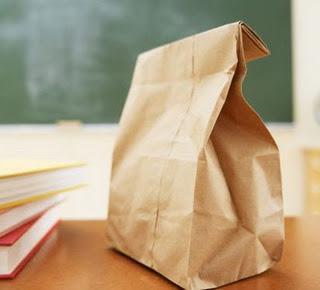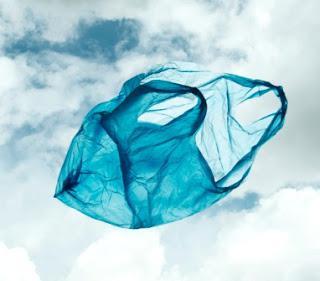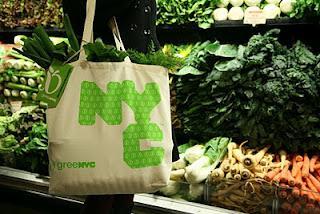Paper or Plastic?
It's the age old question which should be relatively easy to answer. Paper right?
Paper comes from trees – and lots of them. The paper grocery bag is an American innovation and was designed in 1883. It’s made from kraft paper – the word ‘kraft’ coming from the German language meaning ‘strong’. Kraft paper is known for its strength and course texture. It’s strength lends to its reusability.  According to the American Forest & Paper Association, 2007 marked an all-time high of 56% for the recycling of paper consumed in the U.S. Curbside paper collection is easy and readily available in most parts of the country. While I applaud the consumer and the industry for reaching this goal and beyond (the industries goal is 60% by 2012) I’d like to point out that the manufacturing of paper products, like plastic, consumes natural resources and creates pollution. As a matter of fact, the production of a paper bag consumes 1 gallon of water (yep, per bag) equating to 50 times that of plastic bags. Yikes! How does a paper bag get from forest to grocery store?
According to the American Forest & Paper Association, 2007 marked an all-time high of 56% for the recycling of paper consumed in the U.S. Curbside paper collection is easy and readily available in most parts of the country. While I applaud the consumer and the industry for reaching this goal and beyond (the industries goal is 60% by 2012) I’d like to point out that the manufacturing of paper products, like plastic, consumes natural resources and creates pollution. As a matter of fact, the production of a paper bag consumes 1 gallon of water (yep, per bag) equating to 50 times that of plastic bags. Yikes! How does a paper bag get from forest to grocery store?
Trees are found, marked and felled. Machinery is then used to remove the logs from the forest floor – whether by logging or, in more remote areas, helicopters. Machinery requires fossil fuels and roads (which destroy habitat) thereby creating stress on the forests’ inhabitants (even logging a small area has a large impact on the entire ecological chain in surrounding areas). Trees must dry at least three years before they can be used to make paper. Once aged, machinery is used to strip the bark, which is then chipped into 1 inch squares and cooked under tremendous heat and pressure. This wood stew is then ‘digested’ with a limestone and sulfurous acid for eight hours. The steam and moisture is vented to the outside atmosphere, and the original wood becomes pulp. It takes approximately three tons of wood chips to make one ton of pulp. The pulp is then washed and bleached, both stages requiring thousands of gallons of clean water. Coloring is added to more water, and is then combined in a ratio of 1 part pulp to 400 parts water to make paper. The pulp/water mixture is dumped onto a web of bronze wires, the water showers through, leaving the pulp to dry. This final product is then rolled into paper. Whew! What a lot of resources to just make the paper. We must include all of the chemicals, electricity, and fossil fuels used in the shipment of this raw material and in the production and shipment of a finished paper bag.  Paper, when thrown away, can either be recycled or end up in the landfill. If it finds its way to the landfill, over time (and usually many, many, many years) it will break down into organic material. Paper bags can also be recycled in your yard (used as an effective weed barrier under top soil) and it will break down much faster. We all know that plastic bags are bad for the environment because they take a very long time to degrade anywhere between 500-1000 years, and most of them end up in landfills and I'm sure we've all seen the photo of the sea turtle with a piece of plastic bag stuck in its mouth. Not to mention the plastic bags can get drains clogged resulting in major flooding much like the flooding Port of Spain experienced earlier this week.
Paper, when thrown away, can either be recycled or end up in the landfill. If it finds its way to the landfill, over time (and usually many, many, many years) it will break down into organic material. Paper bags can also be recycled in your yard (used as an effective weed barrier under top soil) and it will break down much faster. We all know that plastic bags are bad for the environment because they take a very long time to degrade anywhere between 500-1000 years, and most of them end up in landfills and I'm sure we've all seen the photo of the sea turtle with a piece of plastic bag stuck in its mouth. Not to mention the plastic bags can get drains clogged resulting in major flooding much like the flooding Port of Spain experienced earlier this week.
Let's take a look at what it takes to make plastic.
Plastic bags are typically made from oil, a non-renewable resource. Plastics are a by-product of the oil-refining process, accounting for about four percent of oil production around the globe. The biggest energy input is from the plastic bag creation process is electricity.
So you may be wondering "What about biodegradable plastic bags" and the truth about biodegradable plastic bags are some bags marked “biodegradable” are not actually so, they are recycled plastic mixed with cornstarch. The cornstarch biodegrades and the plastic breaks down into tiny little pieces but does not actually “biodegrade,” you're just left with little pieces of plastic and a huge mess to clean up.
According to a life cycle analysis by Franklin Associates, Ltd, plastic bags create fewer airborne emissions and require less energy during the life cycle of both types of bags per 10,000 equivalent uses — plastic creates 9.1 cubic pounds of solid waste vs. 45.8 cubic pounds for paper; plastic creates 17.9 pounds of atmospheric emissions vs. 64.2 pounds for paper; plastic creates 1.8 pounds of waterborne waste vs. 31.2 pounds for paper.
Paper bags can hold more stuff per bag — anywhere from 50 percent to 400 percent more, depending on how they’re packed, since they hold more volume and are sturdier. The numbers here assume that each paper bag holds 50 percent more than each plastic bag, meaning that it takes one and half plastic bags to equal a paper bag — it’s not a one-to-one comparison, even though plastic still comes out ahead.  From an energy standpoint, plastic takes less energy to make, these numbers are expressed in millions of British thermal units (Btus) per 10,000 bags, again at 1.5 plastic bags for every one paper bag. Plastic bags require 9.7 million Btus, vs. 16.3 for paper bags at zero percent recycling; even at 100 percent recycling rates, plastic bags still require less — 7.0 to paper’s 9.1. That being said we think reusable bags are better for the environment than both paper and plastic, according to this Australian study, canvas bags are 14 times better than plastic bags and 39 times better than paper bags.
From an energy standpoint, plastic takes less energy to make, these numbers are expressed in millions of British thermal units (Btus) per 10,000 bags, again at 1.5 plastic bags for every one paper bag. Plastic bags require 9.7 million Btus, vs. 16.3 for paper bags at zero percent recycling; even at 100 percent recycling rates, plastic bags still require less — 7.0 to paper’s 9.1. That being said we think reusable bags are better for the environment than both paper and plastic, according to this Australian study, canvas bags are 14 times better than plastic bags and 39 times better than paper bags.
